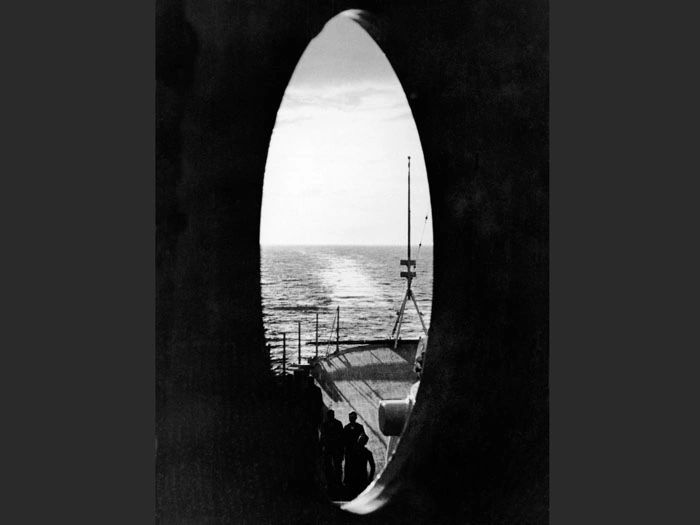USS ASTORIA CA-34
The Official Home of 'Nasty Asty'
From San Pedro to Alaska 1938

CLICK PHOTO TO ENLARGE
The Pacific Fleet illuminated for Navy Day celebrations in a time-lapse photograph, San Pedro CA.
-photo from Brent Jones collection
For the officers and men of USS ASTORIA in the late 1930s, San Pedro, California was home for both them and their ship. They became familiar with all the restaurants and bars, spent their leave up and down the West Coast, and conducted their lives in the manner of peacetime military. This lifestyle was captured in a number of photos reproduced in personal albums at the time, now compiled and displayed here alongside the ship's history.

CLICK PHOTO TO ENLARGE
USS ASTORIA Marines pose outside a Pacific Greyhound bus stop and restaurant in the late 1930s.
-photo from Brent Jones collection

A late 1930s photo of the Navy Landing at San Pedro taken by an ASTORIA sailor. Men are lined up at the train platform to go into Los Angeles.
-photo from Brent Jones collection

An ASTORIA sailor works on a car engine outside an address on N. Hobart Blvd in Los Angeles.
-photo from Brent Jones collection

CLICK PHOTO TO ENLARGE
USS ASTORIA in her pre-1939 configuration. Note the white links in the anchor chain.
-U.S. Navy photo from Brent Jones collection

CLICK PHOTO TO ENLARGE
Closeup view of ASTORIA's starboard catapult circa 1938-9. Squadron VCS-6 planes 7 and 8 are lined up with outboard wings folded. Her searchlights have been painted to match the hull.
-U.S. Navy photo from Brent Jones collection

CLICK PHOTO TO ENLARGE
Closeup view of ASTORIA's stern from the water circa 1938-9. A large canvas canopy stretches across her fantail, rolled up and ready to provide shade for a social event.
-U.S. Navy photo from Brent Jones collection

CLICK PHOTO TO ENLARGE
The annual Fleet Problem drew ships from both Atlantic and Pacific, regardless of where it was staged. On 31 January 1938, sister cruisers USS VINCENNES CA-44 and USS QUINCY CA-39 (background left) join up in San Diego harbor during preparations for Fleet Problem XIX.
-U.S. Navy photo from Brent Jones collection

CLICK PHOTO TO ENLARGE
USS SARATOGA CV-3 off Diamond Head near Honolulu during Fleet Problem XIX, April 1938. Note the wind scoops on her portholes placed by sailors to draw fresh air into their berthing quarters.
-U.S. Navy photo from Brent Jones collection
USS ASTORIA did not participate in the 1938 Fleet Problem until its final phases off the West Coast in late April 1938. Instead, she spent this period conducting a "leisurely steam up the coast to San Francisco and Bremerton."

CLICK PHOTO TO ENLARGE
SOC floatplanes from Cruiser Division 6 in formation. Although their primary responsibility was to scout ahead of a naval force, these utility aircraft were also used for aerial gunfire spotting and other odd jobs.
-photo from Brent Jones collection

The flagstaff and fantail of USS ASTORIA at sunset, viewed from inside the aft superstructure.
-photo from Brent Jones collection
In late June 1938, USS ASTORIA participated in Fleet Week activities in Seattle. In early July she escorted a small tug to the Aleutian Islands. At Dutch Harbor, she picked up the crew of USS SWALLOW AM-4, a ship that had run aground at Kanaga and been rescued by the U.S. Coast Guard Cutter JOHN C. SPENCER.

CLICK PHOTO TO ENLARGE
USS ASTORIA CA-34 at Dutch Harbor, Alaska in July 1938.
-photo from Brent Jones collection

ASTORIA boat crews posing at Dutch Harbor, Alaska in July 1938. Eldred 'Bud" Biggs is at center.
-photo courtesy of Dianne Janis

CLICK PHOTO TO ENLARGE
USS ASTORIA at Puget Sound Navy Yard on 4 August 1938. The battleship in the background is USS WEST VIRGINIA BB-48.
-U.S. Navy photo in NARA collection 19-LCM

Alcatraz Penitentiary viewed from USS ASTORIA in San Francisco Bay, circa 1938. Sailors on ships steaming by would wave and "say hello to Big Al," as notorious gangster Al Capone was imprisoned at Alcatraz into January 1939.
-photo from Brent Jones collection
On 10 September 1938, Richmond Kelly Turner relieved Charles C. Gill to become the fourth Commanding Officer of USS ASTORIA. Shortly after he assumed command, the ship left Long Beach to again visit the San Francisco Bay area.

Above and below: ASTORIA sailors cutting up for the camera in downtown Oakland, circa 27 October 1938. The ship visited Oakland to participate in Navy Day activities.
-photos from Brent Jones collection.


CLICK PHOTO TO ENLARGE
Throughout 1938, war continued to rage in China. An American presence of Sailors and Marines remained to protect interests in the international settlement. In this image, USS AUGUSTA CA-31 is moored off the Shanghai Bund.
-photo from Brent Jones collection

American anger regarding the PANAY incident continued to run high. Above: A philatelic collector's envelope commemorating USS PANAY stamped from Shanghai on the first anniversary of the ship's sinking at the hands of Japanese planes.
Below: A 1938 bubble gum card from the "Horrors of War" series depicts the PANAY incident, including the strafing death of a sailor as lifeboats pull away from the sinking ship.
-from Brent Jones collection


Also throughout 1938, the health of Japanese Ambassador Hirosi Saito began to deteriorate. At odds with his government regarding military action and expansionist policies, Saito absorbed considerable criticism from Japanese and Americans alike. He grew ill and his weight dropped throughout the year, something noted by publications such as Readers Digest.
-photo from Brent Jones collection
Sources
Jones, Brent. Private photo and document collection.
Jones, Pat (ed.) The USS ASTORIA (CA-34) and the Men Who Sailed Her. USS ASTORIA Reunion Association. Privately printed, 1992.
National Archives and Records Administration. http://www.archives.gov/research/
Continue to the Saito Cruise

BACK TO USS ASTORIA HOMEPAGE
